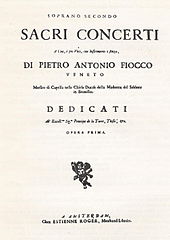Pietro Antonio Fiocco
Pietro Antonio Fiocco (also Pierre-Antoine) (born February 3, 1654 in Venice , † September 3, 1714 in Brussels ) was an Italian composer and conductor who worked in the Habsburg Netherlands.
Life
Fiocco received his musical training in his Italian homeland. Before he was employed in Brussels, he worked in Amsterdam. In 1681 the libretto Helena rapita da Paride was published , for which Fiocco composed the music. In the same year he composed a prologue for Pietro Andrea Ziani's opera Alceste for a performance at the court of Hanover. In the summer of 1682 he came to Brussels and entered the service of the General Hereditary Postmaster Eugen Alexander von Thurn und Taxis, who had been appointed Spanish Prince the previous year .
In 1694, together with the musician Gio Paolo Bombarda, who had advanced to become the governor's financier, he took over the first public opera and theater in Brussels, which had got into financial difficulties. Fiocco composed new prologues for the performances of the operas Amadis , Acis et Galathée (1695), Phaëton and Bellérophon (1697) Armide and Thésée (1697) von Lully at this theater. This was necessary because Lully paid homage to the French king in his prologues; the performance of the same was not appropriate at the time of the performance in Brussels, as it was with France in the War of the Spanish Succession.
In 1700 he again took over the musical direction of the newly founded Monnaie Theater , the Brussels Opera , with Bombarda . In 1703 he became “maître de musique” of the Church of Notre Dame du Sablon , in this function he composed primarily sacred music.
His sons Joseph-Hector Fiocco and Jean-Joseph Fiocco were also well-known composers and musicians in Brussels in the early 18th century.
Works (selection)
- The above-mentioned prologues to operas
- “Le retour du printemps” (pastoral cantata) 1699
- "Tutto acceso d'amore e d'affetto"
- "Sacri concerti a una et pu voci, con instrumenti e senza" (Antwerp, 1691)
- "Missa pro defunctis"
- "Missa Sancti Jesephi"
- Numerous motets such as “Amor patris”, “Averegina ceolorum”, “Sanctorum meritis”, “Festinemuso mortales”, “Fuge demon fuge lepra” and others
- Sonatas for recorder or violin and B. c. (in the style of Corelli with ornate preludes)
- Trio sonatas for two flutes or violins and B. c. ( Estienne Roger , Amsterdam, 1706)
- Various arias
Individual evidence
- ↑ Martin Dallmeier, Martha Schad: Das Fürstliches Haus Thurn and Taxis, 300 years of history in pictures , Friedrich Pustet, Regensburg 1996, ISBN = 3-7917-1492-9, p. 14.
| personal data | |
|---|---|
| SURNAME | Fiocco, Pietro Antonio |
| ALTERNATIVE NAMES | Fiocco, Pierre-Antoine |
| BRIEF DESCRIPTION | Italian-Belgian composer and Kapellmeister of the Baroque |
| DATE OF BIRTH | February 3, 1654 |
| PLACE OF BIRTH | Venice |
| DATE OF DEATH | September 3, 1714 |
| Place of death | Brussels |
